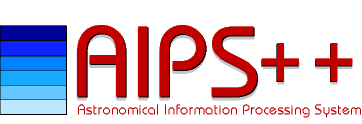
 News
News
| Getting Started | Documentation | Glish | Learn More | Programming | Contact Us |

| Version 1.9 Build 000 |
 News
News
|
object
ObjectID
object-oriented design
object-oriented language
object-oriented programming
on-the-fly calibration
on-the-fly imaging
Open Source
operating system
operator overloading
optical depth
In object-oriented programming, a unique instance of a data structure (abstract data type) encapsulated with a set of routines, called methods which operate on the data. An object is defined according to the template provided by its class. Each object has its own values for the variables belonging to its class and can respond to the messages (methods) defined by its class.
In AIPS++, a globally unique identifier for objects. It is presently a concatenation of the host address, process ID, time, and a per-process unique sequence number. This heuristic suffices for systems that do not ``roll over'' their process ID numbers in a second or less. It is important for persistence.
(OOD): An approach to software design in which a system is modeled as a collection of co-operating objects. The analysis of a problem area to identify its representation in terms of objects, and the specification of the ways in which they must co-operate.
(OOP): An approach to programming based on the "objects" identified by an object-oriented design. Operations on data can be performed only via methods that are common to all objects which are instances of a particular "class" (see inheritance). Thus the interface to each object is well defined, and the code that realizes its methods may be changed so long as this interface remains the same. Each class is a separate code module and has a position in a class hierarchy. Methods or code in one class can be passed down the hierarchy to a subclass or inherited from a superclass. Procedure calls are described in terms of passing messages. A message names a method and may optionally include other arguments. When a message is sent to an object, the method is looked up in the object's class to find out how to perform that operation on the given object. If the method is not defined for the object's class, it is looked for in its superclass and so on up the class hierarchy until it is found or there is no higher superclass. Procedure calls always return a result object, which may be an error, as in the case where no superclass defines the requested method.
A programming language designed specifically to provide strong support for object-oriented design and programming. The first example was SIMULA-67, used in the early 1970's. Recent examples include Smalltalk, C++, Object Pascal, Objective C, and Eiffel.
(synonymous with on-demand calibration). Occurs when computations are interposed between the user and the raw data. In AIPS++, this is accomplished via use of virtual Tables.
A form of single dish observing and subsequent imaging in which the antenna is slewed continuously across the sky and data are recorded on a time scale short compared to the time in which the antenna moves in angle by an entire beamwidth. The pointing position, possibly including pointing error estimates, is recorded with the data. Proper imaging requires use of the pointing data.
In the weak form, the philosophy that the source code for software should be open to all. In the strong form, the philosophy that the ability to provide corrections and additions should also be open to all. Such software is often covered by the Gnu General Public License. AIPS++ is Open Source in the weak form, but we prefer to get to know our developers. If you are interesting in developing for us, please contact us at aips2-request@nrao.edu.
(OS): The low-level software which schedules tasks, allocates storage, handles the interface to peripheral hardware and presents a default interface to the user when no application program is running.
The OS may be split into a kernel which is always present and various system programs which use facilities provided by the kernel to perform higher-level house-keeping tasks, often acting as servers in a client-server relationship.
Use of a single symbol to represent operators with different argument types, e.g. "-" used either as a monadic operator to negate an expression or as a dyadic operator to return the difference between two expressions. Another example is "+" used to add either floating-point numbers or matrices. Overloading is also known as ad hoc polymorphism.
A measure of the integrated opacity along a path through a layer of
material, measured by the absorption of a beam of incident radiation.
The ratio of the emergent intensity I to the incident intensity
 defines the optical
depth
defines the optical
depth  through
through
I/I = exp(-
= exp(- )
)
You could now go back to the:
Copyright © 1995,1996,1999,2000 Associated Universities Inc., Washington, D.C.
abridle@nrao.edu, 20 August 1996, 11:25 EDT